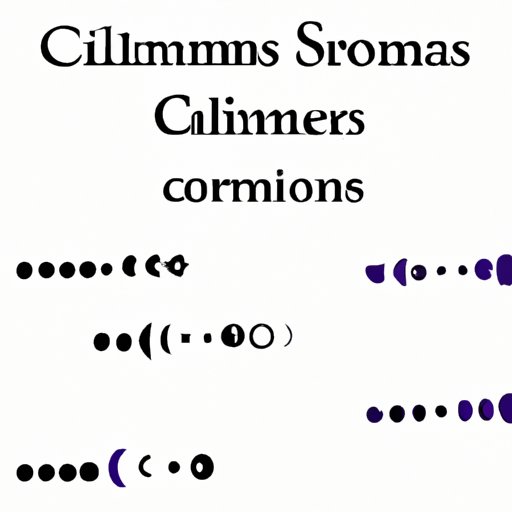
Introduction
Have you ever had a moment in your writing when you weren’t sure whether to use a comma or a period? Enter the semicolon— a punctuation mark that is often overlooked but can greatly enhance your writing. While it may not be the most commonly used punctuation, mastering the semicolon can add clarity, complexity, and sophistication to your writing. In this article, we’ll explore when to use semicolons, provide examples, and dispel some common myths.
Mastering the Art of Punctuation: A Guide to Using Semicolons
A semicolon is a punctuation mark represented by a dot above a comma (;) and is used to connect two closely related independent clauses. Unlike a comma, it creates a stronger connection between the two clauses. Semicolons are commonly used to separate items in complex lists, to combine related ideas, or to emphasize the relationship between the two sentences.
For example: “She is an excellent writer; I always enjoy reading her work.”
In this sentence, the semicolon connects two independent clauses that could stand alone as sentences but are closely related to one another. The semicolon serves as a more effective connector than a period or comma since it allows the ideas to flow into one another more logically.
Semicolons Made Simple: When to Use Them in Your Writing
Semicolons can be used to create a clearer, more concise sentence when separating items in complex lists. For example: “I need to buy milk, bread, and eggs from the grocery store; a new beach towel, sunscreen, and a book for vacation; and a gift for my mom’s birthday.”
In this sentence, the semicolon separates the separate items on the list and avoids confusion, making the sentence easier to understand.
Semicolons can also be used to connect related ideas or clauses. For example: “The sun is shining; it’s the perfect day to go to the beach.”
In this sentence, the semicolon connects two independent clauses that can stand alone as separate sentences but are closely related to one another. By using a semicolon instead of a period or comma, the connection between the two clauses is emphasized.
Breaking Down the Semicolon: A Writer’s Guide to Proper Usage
While semicolons can greatly enhance your writing, it’s important to use them effectively. Here are some tips to help you use semicolons properly:
1. Avoid overuse: Overusing semicolons can distract readers and weaken the intended impact. Use semicolons sparingly and only when necessary.
2. Connect truly related ideas: Make sure that the items or ideas you are connecting with a semicolon are truly related. If they are not, then use a period or another punctuation mark instead.
3. Use semicolons to avoid confusion: In sentences that already contain commas, using a semicolon can help avoid confusion. For example: “My parents, who live in California, and my siblings, who are in New York, are planning to visit me this weekend; we’re going to have a big family dinner.”
In this sentence, the semicolon clarifies the separate ideas introduced by the two sets of clauses.
3 Common Misconceptions About Using Semicolons (And How to Avoid Them)
There are many myths and misunderstandings about semicolon usage that can lead to improper use. Here are three common misconceptions:
1. Semicolons are too formal: While semicolons may be seen as more formal than commas or periods, they can add sophistication to your writing and enhance the meaning and clarity of your sentences.
2. Semicolons are interchangeable with commas: While both semicolons and commas are used to connect ideas or clauses, they serve different functions. Semicolons create a stronger, more direct connection between the related ideas, while commas function to separate items in lists or clauses in a sentence.
3. Semicolons are difficult to use: While it may take some practice to master the use of semicolons, they are a valuable tool for writers and can add clarity and sophistication to your writing.
Semicolons vs. Commas: Understanding the Differences and When to Choose Each
Knowing when to use a semicolon versus a comma is an essential part of mastering proper punctuation. Use a semicolon when you want to connect two closely related independent clauses, or when separating items in complex lists. Use a comma when you want to separate items in a list, connect dependent and independent clauses, or to indicate a pause in the sentence.
For example: “I forgot my keys and had to call my roommate for help; however, she was at work.”
In this sentence, the semicolon separates two related independent clauses, while the comma separates the dependent and independent clauses.
Semicolons for Clarity: How to Use Them to Connect Related Ideas
Using semicolons can greatly enhance sentence clarity and reduce confusion. Instead of using a period or a comma, a semicolon can connect two related ideas or clauses to make the sentence flow more logically.
For example: “The concert was amazing; the band played all of my favorite songs.”
In this sentence, the semicolon connects two separate independent clauses that could stand alone as separate sentences but are closely related to each other.
The Power of the Semicolon: Enhancing Your Writing With Proper Punctuation
Mastering the art of using semicolons can take your writing to the next level. Using semicolons properly can add clarity and sophistication, and make your writing more understandable and engaging. By mastering proper punctuation use, your writing can leave a lasting impression on your readers.
Conclusion
Proper usage of semicolons is essential for any writer who wants to create clear and concise writing. Although it may take some practice to master the art of using semicolons, it is well worth the effort. By understanding when and how to use semicolons, you can take your writing to the next level. Next time you’re unsure about whether to use a comma or a period, remember the power and effectiveness of the semicolon.
Encourage readers to put their newfound knowledge to use in their writing, now that they understand the power of the semicolon.




